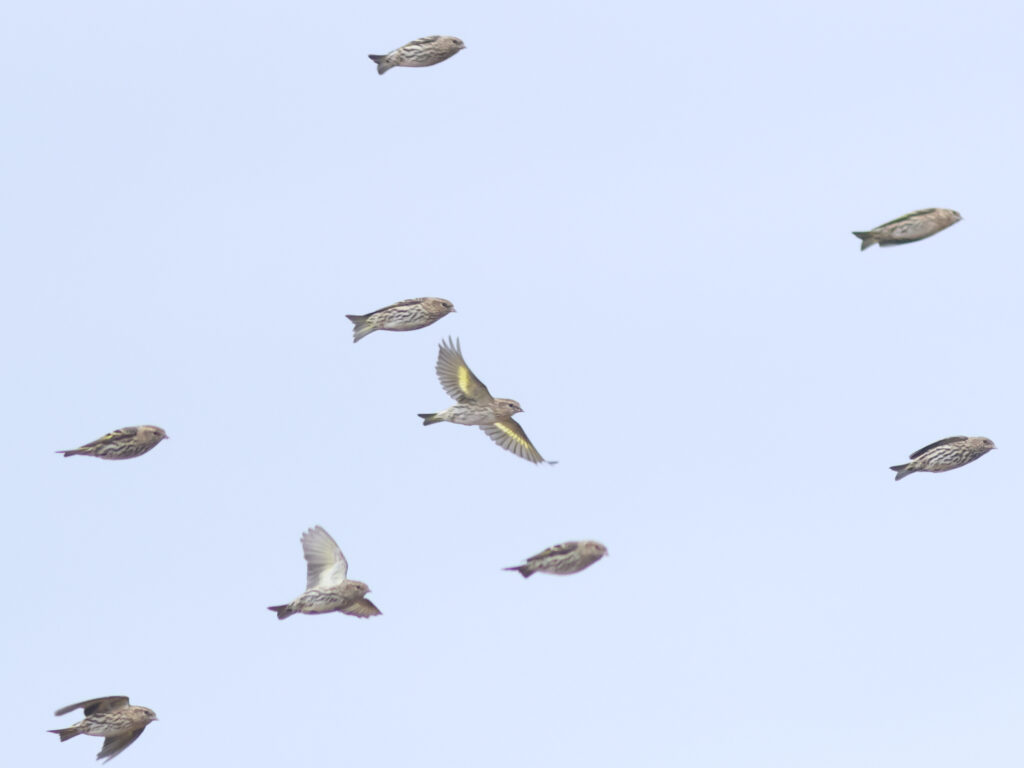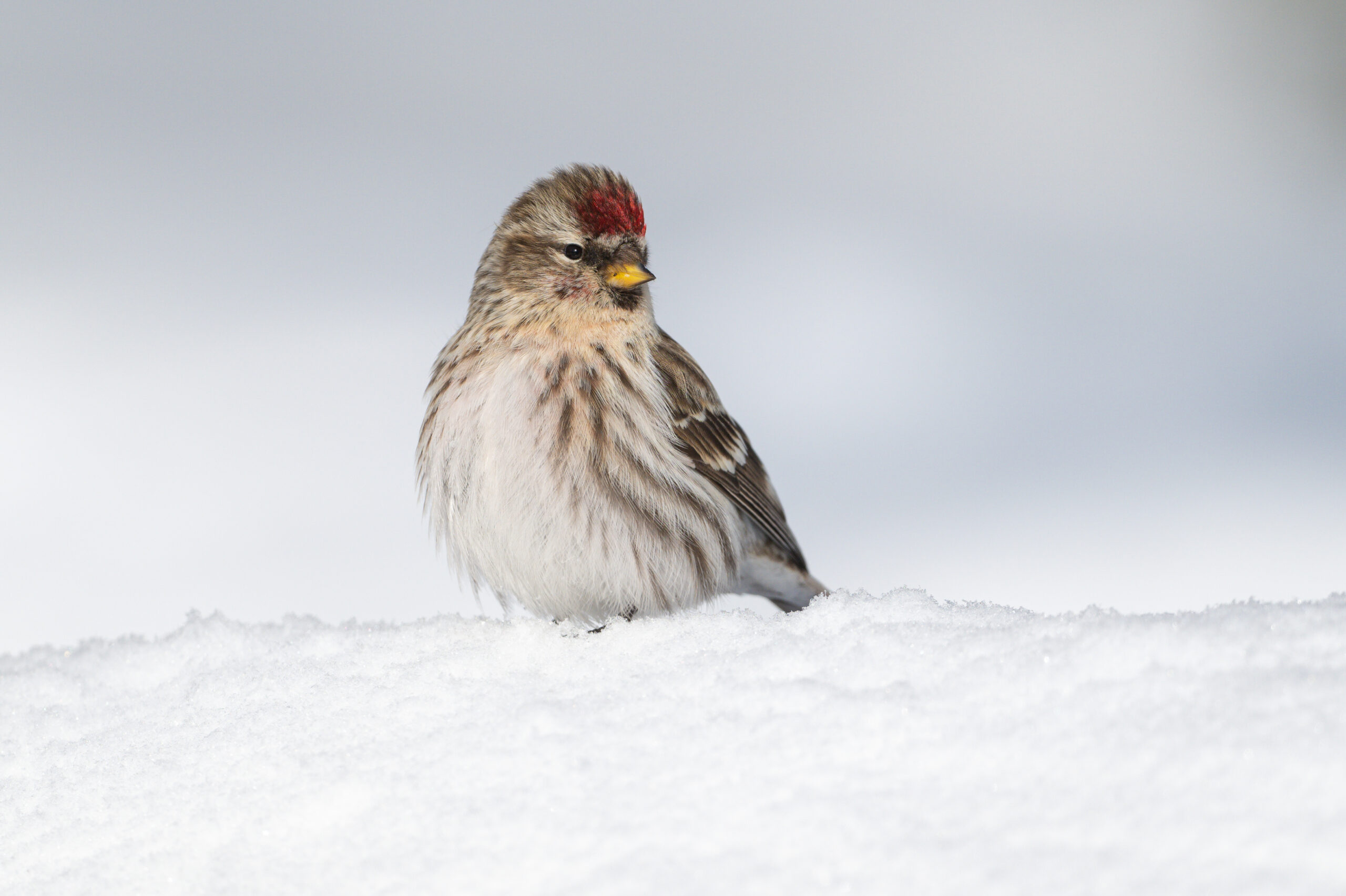By Tyler Hoar
Featured Post Photo: ©David Turgeon
GENERAL FORECAST
It looks to be a flight year for many species in Eastern Canada. With mostly very poor crops in the boreal forest from central Quebec westward to Manitoba, this has the potential of being the biggest flight year since 2020-2021.
In these very poor crop areas in the eastern boreal, significant food source species such as White Spruce, Tamarack and White Birch have a total absence of any new crop over large areas. The almost regularly dependent food sources, like Black Spruce and alders, are below average within these same areas. A very early movement of a small but widespread flight of Redpolls in eastern Canada is pointing to a possible poor seed crop in Northern Quebec and Labrador.
There are two areas with significant cone crops. The first area is from the Adirondack mountains in New York, east through New England, Gaspe Quebec, and the Maritime provinces to southern Newfoundland, where there is a widespread above-average cone crop this year. The second area, from Northeastern Manitoba through the Northwest Territories into parts of Alaska and southward into the mountains of Western Canada and United States, also has a widespread above-average multi-species food crop.
Spruce Budworm outbreaks from Manitoba eastward were widespread this summer, providing ample food sources to Evening Grosbeaks, Pine Siskins and Purple Finches as well as the “budworm warblers” during the breeding season.
Purple Finches and Red-breasted Nuthatches have been moving south in numbers since mid-August.
INDIVIDUAL FORECASTS
Forecasts apply mainly to Ontario and adjacent provinces and states. Three irruptive non‐finch passerines whose movements are often linked to finches are also discussed. Follow finch wanderings this fall and winter on eBird, the Finch Research Network and the Finches, Irruptions and Mast Crops Facebook group for more information.
PINE GROSBEAK
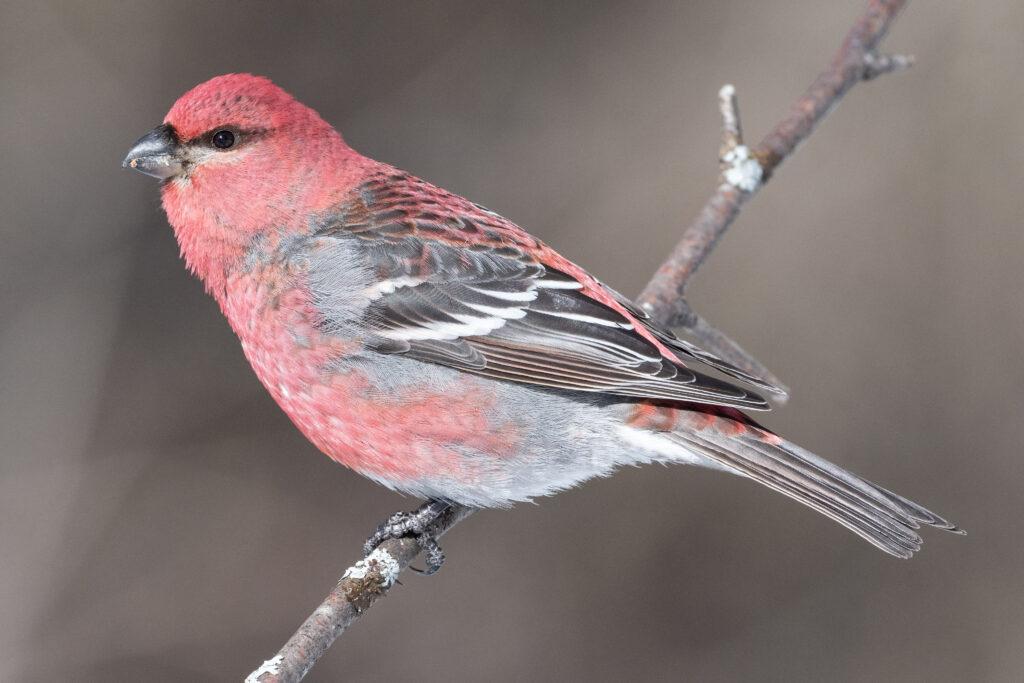
There should be a small to moderate flight of Pine Grosbeaks this winter south to southern Ontario, southern Quebec and the border states. The crop of Mountain Ash appears below average to poor from Lake Superior across the boreal forest into eastern Quebec. Either side of this area, the crop appears to be above average.
Individuals wandering southward will look for European Mountain-ash berries and small ornamental crabapples even in urban areas. At feeders, they prefer black oil sunflower seeds.
PURPLE FINCH
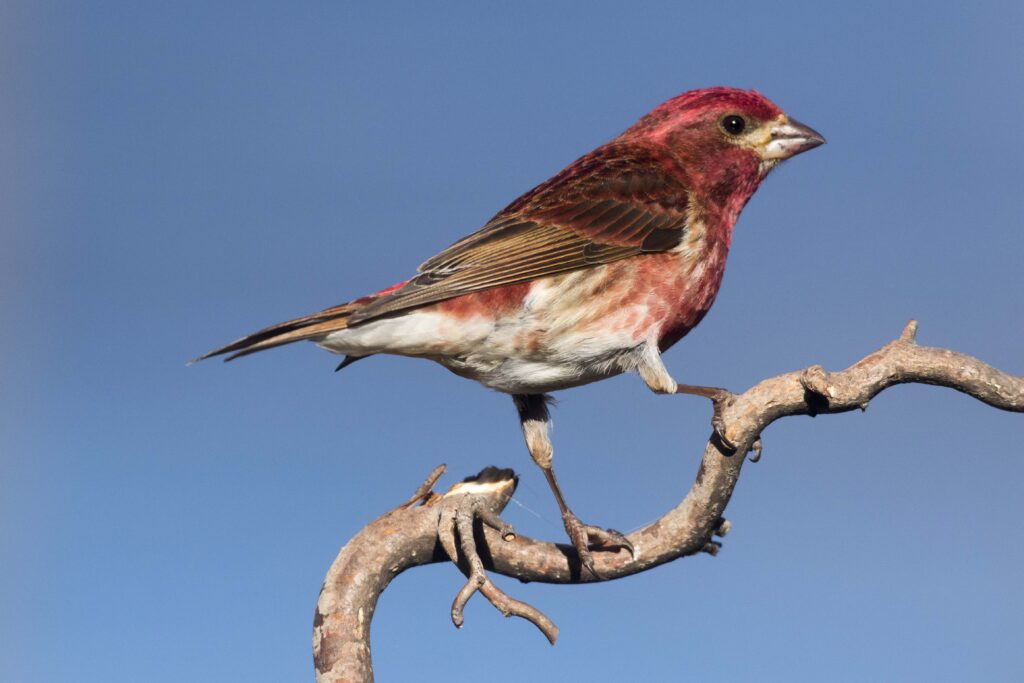
Most Purple Finches will migrate south out of Eastern Canada this winter with some making it to the deep southern States. Reports of early movement have been occurring for weeks. Many young finches benefited from the ample food source provided by the widespread spruce budworm outbreaks, and this led to them moving in search of food weeks ago.
At feeders, they prefer black oil sunflower seeds. Away from feeders, this species is known to feed on lilac, ash, and other deciduous seeds during the winter.
REDPOLL
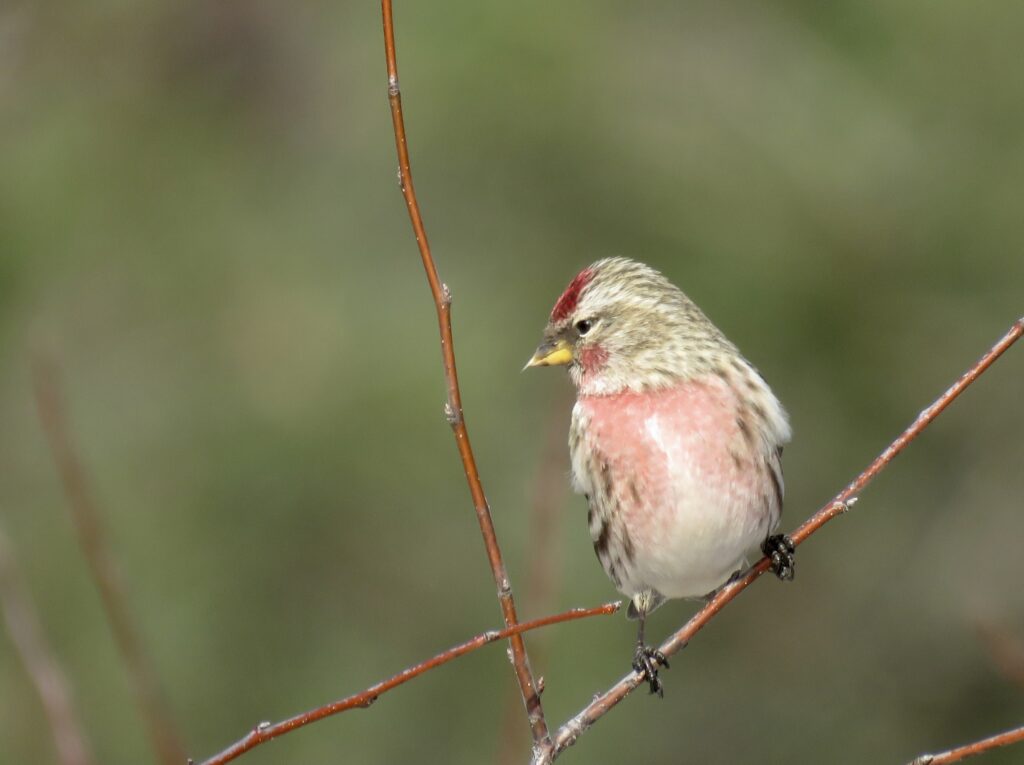
Expect a probable strong flight south out of the boreal forest east of Lake Superior southward into the lower great lakes, eastward through northern New York, New England and the Maritime provinces. Many of the Redpolls coming out of the central-western subarctic/arctic regions should gravitate toward the Manitoba westward cone crop. The early and widespread but not unprecedented flight into Northern Ontario eastward to Newfoundland this August is pointing towards a more widespread crop failure of birches and Alders in Northern Quebec. The very poor crop to complete absence of the White Birch and Tamarack crop in areas from Manitoba eastward to central Quebec, plus the below-average alder and swamp birch crops, should force the majority of the redpolls southward once snow covers the weedy fields in the boreal.
Watch for redpolls on birches (including in urban area), in weedy fields and at bird feeders offering nyjer®and black oil sunflower seeds.
In 2024, Common Redpoll, Hoary Redpoll and the Lesser Redpoll in Europe have all been lumped into the same species, now called Redpoll. Genetic work found that a supergene was responsible for the Redpoll plumage differences.
Watch for “Hoaries” in flocks of “Common” Redpolls. See the link below for photos and identification marks of the Redpoll subspecies.
RED CROSSBILL
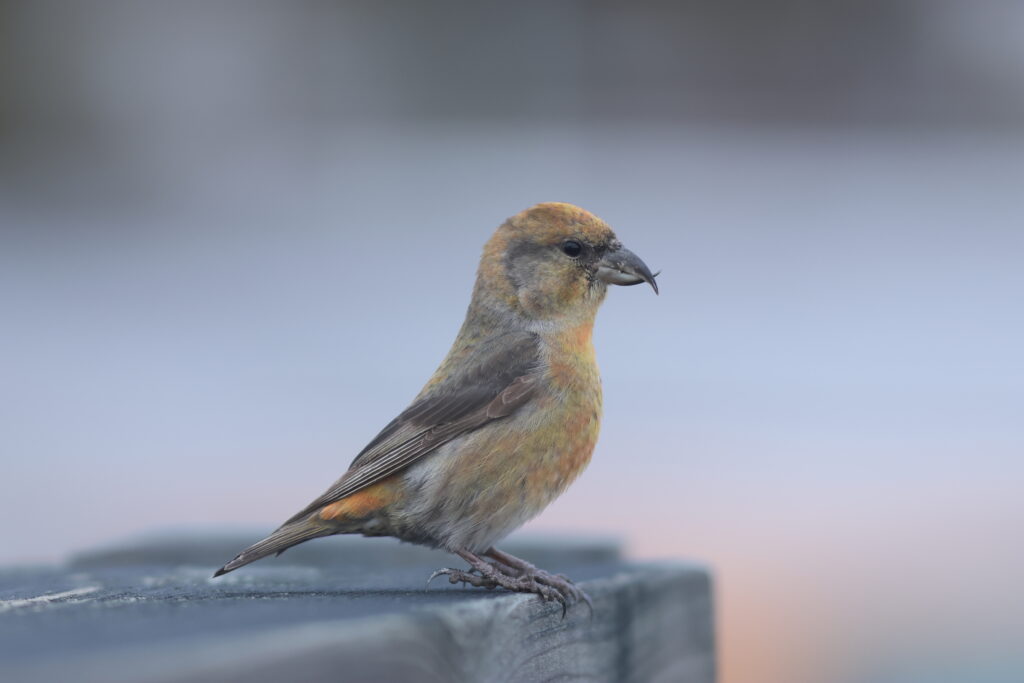
There is a good mixed conifer crop throughout the Maritimes provinces and northeastern states westward to upstate New York. Type 12 Red Crossbills are in their usual conifer haunts across the Northeast, and this should continue through much of the winter. A few Type 1 Red Crossbills will be scattered about as well.
There should be more modest numbers from Algonquin Provincial Park over to the upper Great Lakes states. Don’t expect to see much in the way of any irruption from the west (Type 2 being maybe a wild card).
There may be a movement late winter down the coast to Long Island, Cape May, Delaware, and points south, as they sometimes do, as cone crops are depleted as we progress through the winter season.
The Red Crossbill types are usually impossible to identify without recordings of their flight calls. Recordings can be made with a smartphone and identified to type. Matt Young (info@finchnetwork.org) will identify types if you email him your recordings or upload them to an eBird checklist. Recordings uploaded to eBird checklists are deposited in the Macaulay Library. See the link below for Red Crossbill call types.
WHITE-WINGED CROSSBILL
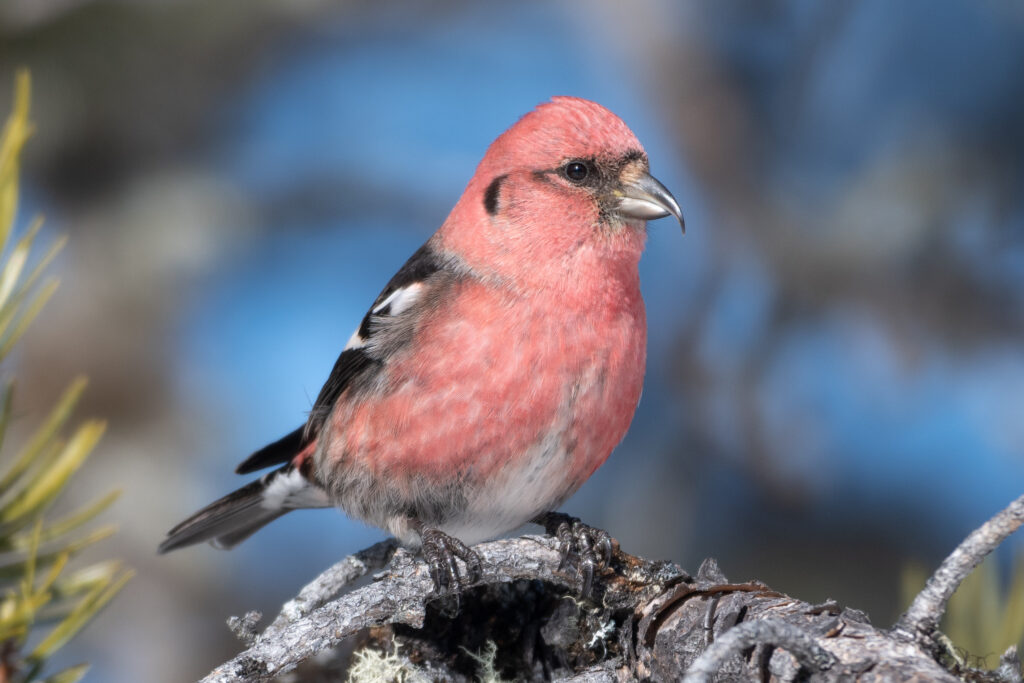
The Crossbill Pendulum has swung west for the winter of 2025-26. An excellent spruce crop from northeastern Manitoba to Alaska and down the mountains of western Canada should contain the majority of White-winged Crossbills this winter. Flocks were observed leaving the Hudson Bay Lowlands of Northern Ontario, moving westward in June. Most crossbills remaining in the east should gravitate towards the New England-Maritimes spruce crop. Outside of these two spruce crops, expect scattered flocks and individuals randomly moving around the Great Lakes area in search of suitable food sources, including any cone-laden Spruces (including ornamentals) within urban areas.
The difference the presence of a cone crop can make –The author worked six weeks in the boreal forest in Northern Ontario in 2024 and 2025. 2024 had an above average Tamarack crop ripen, which resulted in observing 1100+ crossbills. The same area in 2025 had no cone crop, which resulted in only five crossbills being observed.
PINE SISKIN
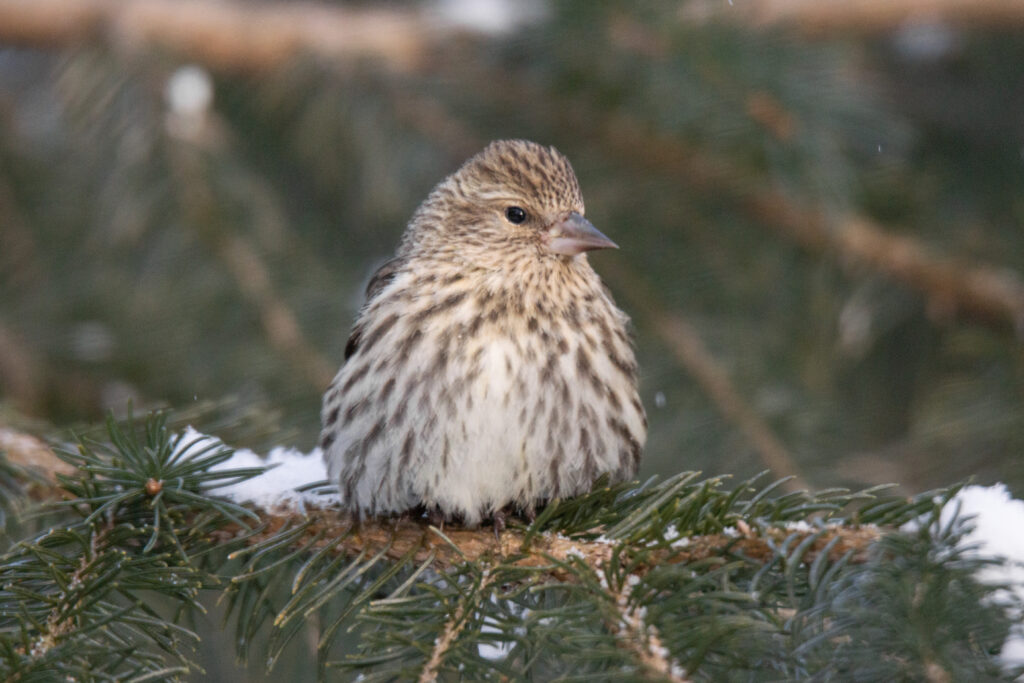
Areas affected by Spruce Budworm infestations provided widespread and bountiful food during the breeding season, but these same areas also have a very poor cone crop for the winter. Siskins that bred in these areas will be on the move.
As seen by band recoveries, Pine Siskins, similar to White-winged Crossbills, will move east or west in search of cone crops. This year, birds will move towards both extensive cone crop areas. But with the widespread and extensive very poor White Spruce and White Birch crop in the eastern boreal forest, there should be a moderate to possibly strong flight of siskins southward, possibly as far south the mid Atlantic states.
An above-average Eastern White Cedar crop around the lower Great Lakes will attract some flocks for the winter.
This entertaining species prefers nyjer® seeds in silo or sock feeders.
EVENING GROSBEAK
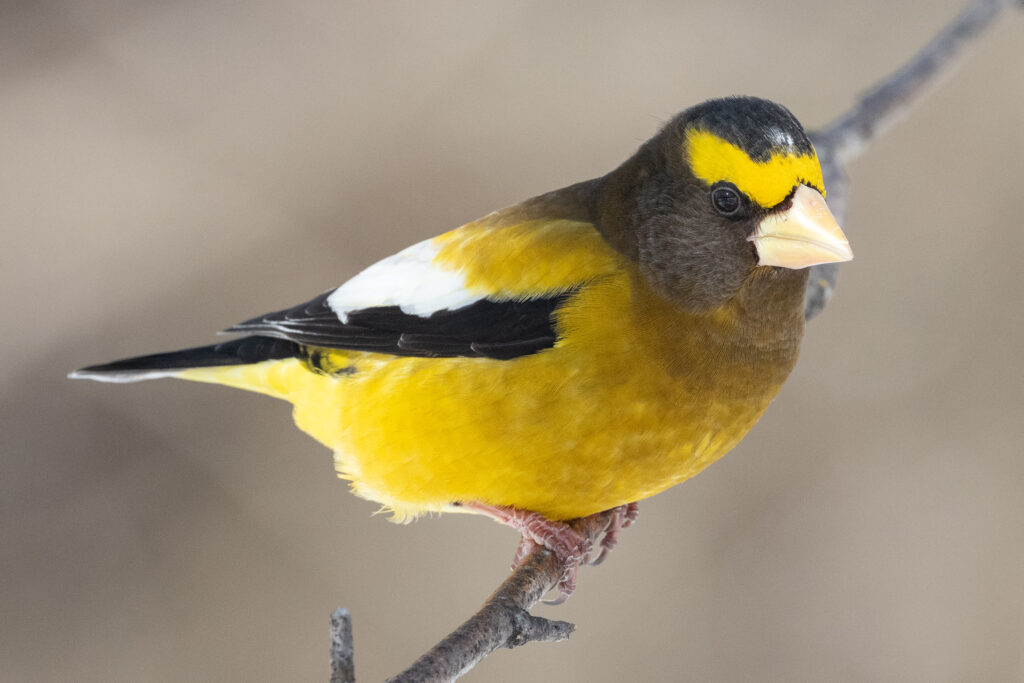
Like the other budworm-loving finches, Evening Grosbeaks were widespread in these areas, rearing families on this abundant food source. Food sources used post-budworm, like cherry species, ash, and mountain ash, had poor crops over widespread areas.
There should be a moderate flight of Evening Grosbeaks southward this fall. Depending on the direction and timing when Evening Grosbeaks come out of the boreal forest, some flocks may winter further south of their usual areas. The eastern cone crop area should hold wintering flocks in southern Quebec, the Maritime provinces, New England states, and New York this winter. A few birds likely make it to Pennsylvania and perhaps the higher elevations of the Mid-Atlantic States as well.
Evening Grosbeaks in northwestern Ontario should move out of the boreal forest and look for feeders in towns or other suitable food sources.
At platform feeders, Evening Grosbeaks prefer black oil sunflower seeds. Evening Grosbeaks will look away from feeders for maple and ash trees still holding seeds. See the links section below for Evening Grosbeak call types eBird article, and The Evening Grosbeak Road to Recovery Project.
THREE IRRUPTIVE PASSERINES
Movements of these three passerines are often linked to the boreal finches.
BLUE JAY
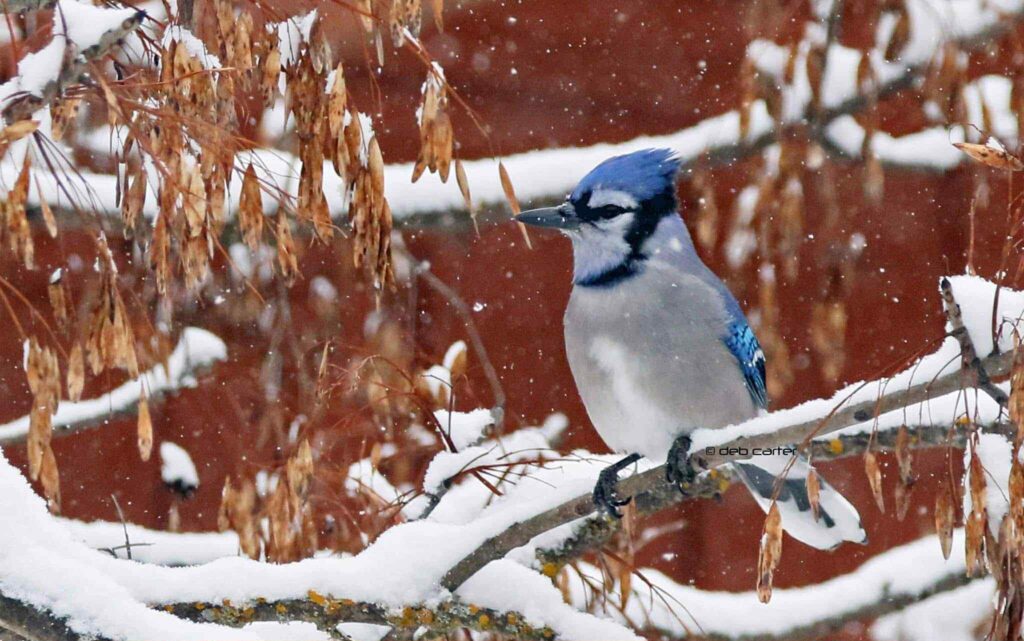
This will be an average flight along the north shorelines of Lakes Ontario and Erie. The beechnut and acorn crop is widespread, ranging from poor to average in volume. Areas around central Ontario and the Laurentian mountains of southwestern Quebec are reporting above-average crops.
With the poorer crops west of Lake Superior, there should be an above-average flight of Blue Jays southward.
RED-BREASTED NUTHATCH
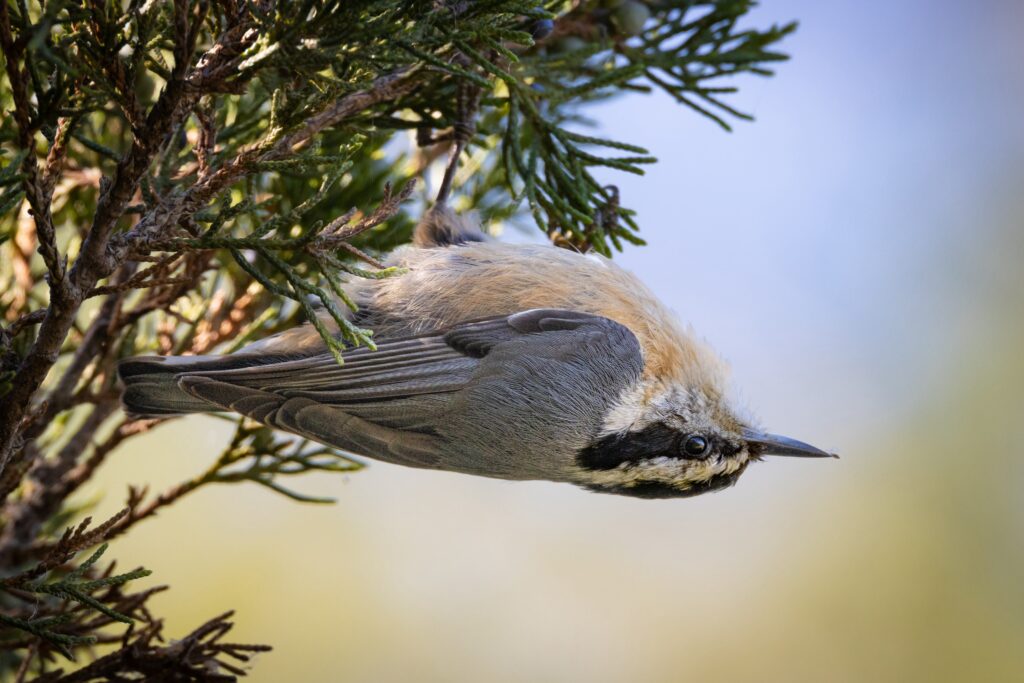
This species has been irrupting south since mid-August and continues to irrupt. Individuals have made it as far as the Alabama Gulf Coast. With poor cone crops in the eastern boreal forest, expect this species to continue to move southward. At feeders, this species prefers black oil seeds, suet, and peanuts.
BOHEMIAN WAXWING
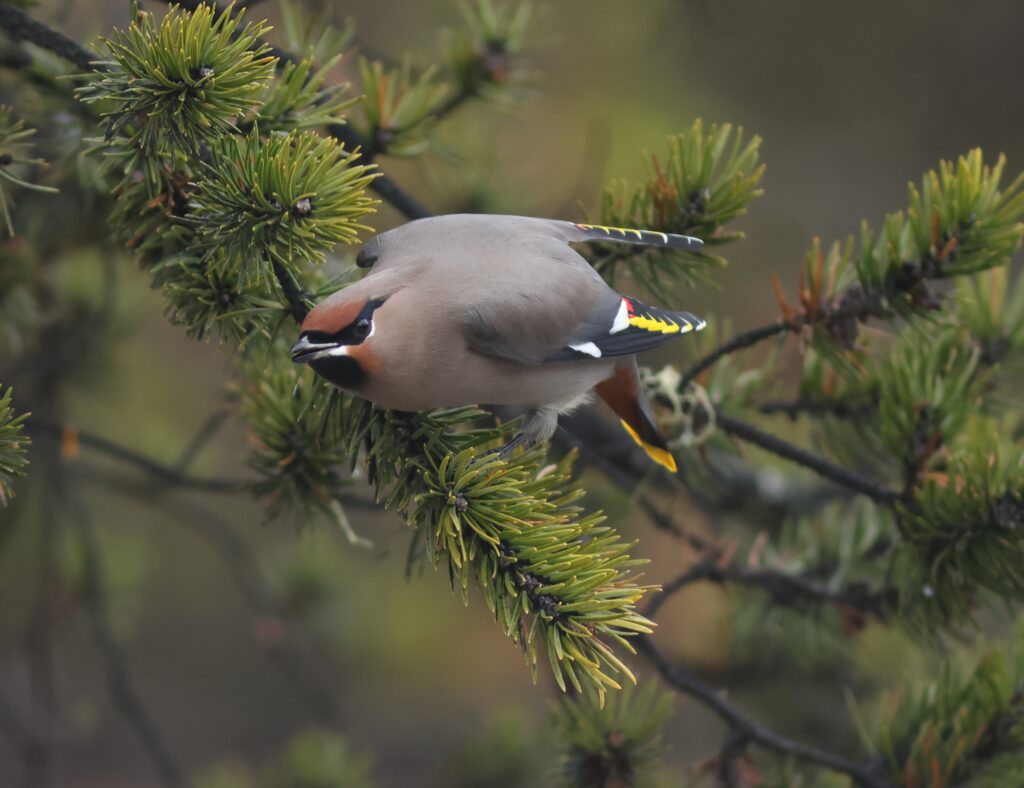
Bohemian Waxwings in Manitoba westward should remain close to the boreal and mountain forests this winter. Most bohemians east of Manitoba will likely be on the move, looking for suitable fruit crops. With the native mountain ash crop poor east of Lake Superior, bohemians should be moving into their traditional areas from Central Ontario eastward into the Maritime Provinces and northern New England by early winter. Some individuals should show by mid-fall, possibly hidden within Cedar Waxwing flocks.
Areas of the lower Great Lakes have experienced drought conditions since late summer, and scattered berry crop failures have been noticed. This may force Bohemian Waxwings to roam further than their traditional wintering ranges in search of food over the latter part of winter.
Bohemians coming south to forage on reliable annual crops of abundant Buckthorn (Rhamnus) berries, Red Cedar, wild grape, will also forage on planted European Mountain-ash berries and ornamental crabapples within settlements.
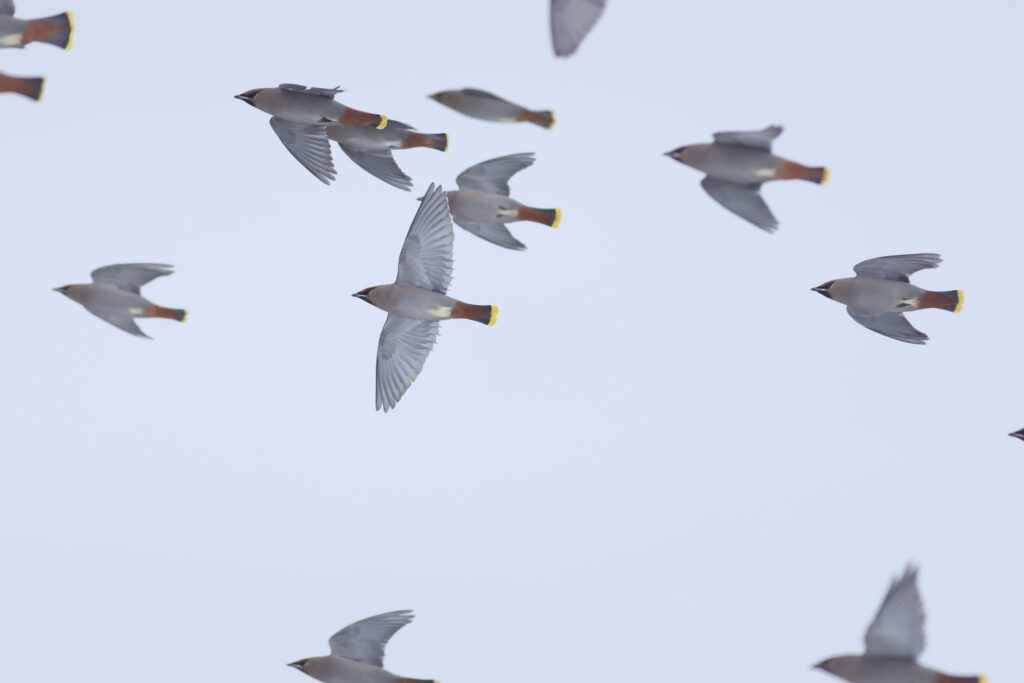
The Finch Research Network (FiRN) is a nonprofit, and was granted 501c3 status in 2020. We are a co-lead on the International Evening Grosbeak Road to Recovery Project, and have funded almost $22,000 to go towards research, conservation and education for finch projects in the last couple years. FiRN is committed to researching and protecting these birds like the Evening Grosbeak, Purple Finch, Crossbills, Rosy-finches, and Hawaii’s finches the honeycreepers.
If you have been enjoying all the finch forecasts, blogs and identifying of Evening Grosbeak and Red Crossbill call types (20,000+ recordings listened to and identified), redpoll subspecies and green morph Pine Siskins FiRN has helped with over the years, please think about supporting our efforts and making a small donation at the donate link below. The Evening Grosbeak Project is in need of continued funding to help keep it going.
Donate – FINCH RESEARCH NETWORK (finchnetwork.org)
Book Link
For help with Finch ID and much much more, here is a link to the exciting and newly released Stokes Guide to Finches of the United States and Canada: https://www.amazon.com/Stokes-Finches-United-States-Canada/dp/0316419931
Please think about joining Finch Research Network iNaturalist Projects:
Winter Finch Food Assessment Project/Become a Finch Forecaster: https://finchnetwork.org/the-finch-food-assessment-become-a-finch-forecaster
Finch Information Links
- Crossbills of North America: Species and Red Crossbill Call Types. https://ebird.org/news/crossbills-of-north-america-species-and-red-crossbill-call-types/
- Type 12 Red Crossbill: https://finchnetwork.org/type-12-the-old-northeastern-red-crossbill
- A Crossbill’s Guide to Conifers of the Eastern Forest: https://finchnetwork.org/a-crossbills-guide-to-conifers-of-the-northeastern-forest
- Finch Research Network with finch species information https://finchnetwork.org/
- Evening Grosbeak Call Types https://finchnetwork.org/species/grosbeaks/the-evening-grosbeak-project To support research and conservation for this species of conservation concern: https://finchnetwork.org/donate
- Evening Grosbeak Road to Recovery Project: https://finchnetwork.org/projects/the-evening-grosbeak-project
- Subspecies of Common and Hoary Redpolls – ID Tips and Photos.http://www.jeaniron.ca/2015/redpollsRP.htm
- Redpolls are Lumped: Redpolls United! Highlights from the 2024 AOS Checklist Update | All About Birds[TH1]
- Red Crossbill North American iNat Foraging Project: https://finchnetwork.org/crossbill-foraging-project
- Evening Grosbeak North American iNat Foraging Project: https://finchnetwork.org/evening-grosbeak-foraging-project
- Previous Winter Finch Forecasts 1999-2019: http://www.jeaniron.ca/WFFindex.htm
- 2020-2024 Winter Forecasts are available under the menu at https://finchnetwork.org/
I would like to thank the many birders, naturalists, biologists, and foresters who share their recordings and tree seed reports to contribute to this forecast:
Denis Barry (central and southern ON), Louise Barteau (ME), Juliet Berger (southeast MI), Alvan Buckley (NFLD and southern Labrador), Peter Burke (central ON), Mark Calhoun (central and northwestern ON), Geoff Carpentier (southern ON and AK), Bernie Carr (northern NY), Caleb Centanni (NY), Joan Collins (Adirondacks NY), Clinton Dexter-Nienhaus (Sax-Zim Bog MN), Bruce Di Labio (ON, MB, PEI), Jessé Roy-Drainville (Gaspesie, and Tadoussac QC), Nancy Dowd (NS),), Jolène Dubé (northern NB), David Elder (Atikokan ON), Michael Ferguson (northern ON), Harold Fisher (central SK), Matthew Forbes ( western MB) Marcel Gahbauer (eastern ON, AB), David Govatski (NH and VT), Glenn Hodgkins (ME), Danica Hogan (Yellowknife NWT), Adam Holder (northern ON), Joel Kayer (MB), Kent Ladell (southwestern AB), Anne Marie Leger (northern NB), Markus Legzdins (northern ON), Mike Lushington (northern NB), Angela MacDonald (NS), Stacy McNulty (Adirondack NY), Mark Peck (Haliburton, Hudson Bay lowlands ON and eastern BC), Anne-Claude Pepin (Cape Breton NS), Brian Ratcliff (Lake Superior and northern ON), Colleen Reilly (Churchill MB), Bill Sheehan (northern ME), Sachi Snively (central BC), Tim Spahr (MA, BC), Alexandre Terrigeol (Gaspesie and Tadoussac QC), Larry Therrien (western MA), Doug Tozer (northern ON), Declan Troy (AK), Greg Ward (Berkshire County MA), Mary Beth Warburton (NY), Magill Weber (southern ME, southeastern NB), Ken White northwestern BC), Quinten Wiegersma (Algonquin Park ON), and Matt Young (NY, MA).
Thank you to Tim Poole who helped connect the forecast to provincial foresters in Manitoba. Thanks to Deb Carter, Jessé Roy-Drainville, Paul Jones, Mark Peck, David Turgeon, and Matt Young for providing the photos. Thanks to Susan Hall and Matt Young for reviewing the forecast.
27th Annual Winter Finch Forecast: The first was posted to the Ontbirds and Birdchat listservs in 1999.
Tyler Hoar, Oshawa, Ontario. Finch Research Network, September 28, 2025.
